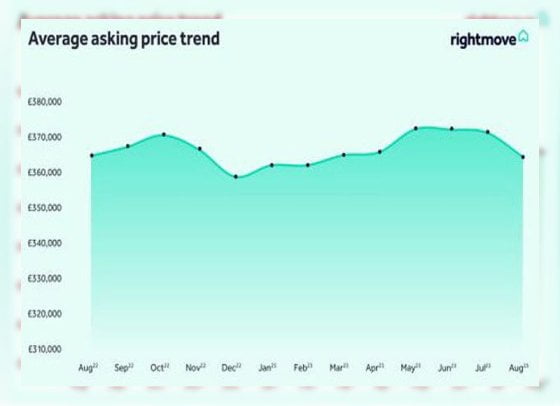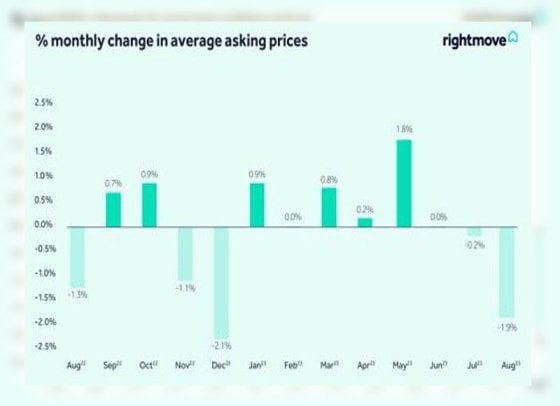Explore the realities of shifting housing market as sellers navigate pricing pressures amidst rising interest rates. Gain insights into changing trends, year-on-year comparisons, and strategies for success. Stay informed with our comprehensive analysis.

Home sellers are gradually coming to terms with the reality that their properties might be worth less than they were a year ago, particularly in light of rising interest rates. In August, the average asking price for new listings decreased by 1.9%, marking the most significant August drop since 2018. This reduction amounts to approximately £7,012, surpassing the usual 0.9% decline seen in August’s customary summer slowdown. This decline signifies that sellers are beginning to acknowledge that in today’s market, their homes might need to be priced lower to secure a sale, after a period of optimistic asking prices.
Nonetheless, on a year-on-year basis, average asking prices have only diminished by 0.1%, as reported by Rightmove. It’s essential to note that this data only considers the asking prices of new listings for each given month and doesn’t encompass properties that have already undergone price cuts. Recent statistics from Hamptons, the estate agent, indicate that in July, 50% of homes in England and Wales were sold following price reductions—an increase from 47% in June and 34% in the previous July.
Henry Pryor, a property expert and professional buying agent, anticipates further price drops. He emphasizes that the impact of higher interest rates is eroding sale prices, leading sellers and agents to adjust their expectations. Pryor believes that while some are attempting to showcase their seriousness by quoting more modest prices ahead of the post-holiday buyer return in September, prices are likely to continue falling. He underscores that current figures exclude sellers who have already reduced their prices, pointing out that three-quarters of properties are now selling below their original asking prices.
In terms of gauging the real state of house prices, ongoing sales agreements provide a better indicator than existing indices, which often rely on limited data and have some time lag. Leading indices from Nationwide and Halifax suggest annual house price declines of 3.8% and 2.4%, respectively. These indices are based on their respective approved mortgage applications. The Land Registry’s house price index, which relies on sold prices, indicated a year-on-year increase of £5,000 in average house prices as of June, although these were £5,000 below the peak witnessed in November the previous year.

READ THIS: Anticipated Energy Price Cap: Potential £150 Annual Savings with Caution and Complexity
Regarding Rightmove’s asking price data, it marks a notable downward shift after several months of minimal movement, barring December. While asking prices have dipped by £8,000 from their May peak, this needs to be understood in the context of substantial price growth over the past four years. Despite this dip, average asking prices remain £59,000 higher than those in August 2019.
Rightmove also notes that the number of agreed property sales is currently 15% lower than in 2019, primarily due to higher mortgage rates causing some to postpone their moving plans. While the average five-year fixed mortgage rate has recently dropped to 5.81%, there are early signs of further improvement. Rightmove’s Tim Bannister explains that the 1.9% drop in asking prices within a month is partly due to the expected seasonal dip, as sellers understand the need to be more flexible with pricing during the quieter summer holiday period. Bannister emphasizes that well-priced homes in various regions are still attracting multiple potential buyers, who might need to act swiftly to secure a property.
Furthermore, the number of available properties is 10% lower than in 2019, with realistically-priced homes in sought-after areas garnering significant buyer interest. Nathan Emerson, CEO of Propertymark, highlights that the sales market remains vibrant despite rising mortgage rates. He notes that member agents report sales figures similar to the busy market period of the previous year. While viewings and valuations have dropped, this indicates a shift toward more determined homebuyers and sellers. Properties priced in line with the market are selling rapidly, and a large portion of sales are occurring below asking prices, enabling buyers to counteract mortgage rate increases.
Read More: